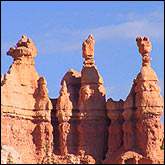What are Hoodoos?
 Hoodoos or Goblins are one of the most spectacular displays of erosion. They are geological formations, rocks protruding upwards from the bedrock like some mythical beings, conveying the story of hundreds and thousands of years of weather erosion.
Hoodoos or Goblins are one of the most spectacular displays of erosion. They are geological formations, rocks protruding upwards from the bedrock like some mythical beings, conveying the story of hundreds and thousands of years of weather erosion.
Most Hoodoos are made of sandstone, sand-sized particles cemented together by calcite, silica, or iron oxide. They are created by erosion. Rains, running water and strong sand winds slowly chip away the material from the bedrock. As some parts of the sandstone are stronger than others, uneven shapes of remains begin forming. Most of the time Hoodoos have a very hard rock on the top, called the Caprock which protects the softer sandstone layers beneath it from further erosion. That is why Hoodoos usually appear as ‘spikey’, ‘human’ looking formations ranging in size from that of a human to that of a ten story building.
Some of the most spectacular Hoodoos exist in the Bryce Canyon National Park in Utah, USA. There, in addition to the erosion modes mentioned above, a process called frost wedging plays a key role in forming Hoodoos. During the day water from the melted snow seeps into the small cracks in the rocks where it freezes during the night. As water expands as it freezes into ice, it causes cracks to expand even wider. At Bryce Canyon there can be over 200 freeze/thaw cycles each year, which speed up the erosion and formation of Hoodoos. Erosion at the Bryce Canyon proceeds at a rate of 2-4 feet of rock being carried away every 100 years. This means that Hoodoos we see there today will be destroyed in several thousand years by the same process that created them.
About the Author
Anton Skorucak, MS
 Anton Skorucak is a founder and publisher of ScienceIQ.com. Anton Skorucak has a Master of Science (MS) degree in physics from the University of Southern California, Los Angeles, California and a B.Sc. in physics with a minor in material science from the McMaster University, Canada. He is the president and creator of PhysLink.com, a comprehensive physics and astronomy online education, research and reference web site.
Anton Skorucak is a founder and publisher of ScienceIQ.com. Anton Skorucak has a Master of Science (MS) degree in physics from the University of Southern California, Los Angeles, California and a B.Sc. in physics with a minor in material science from the McMaster University, Canada. He is the president and creator of PhysLink.com, a comprehensive physics and astronomy online education, research and reference web site.


